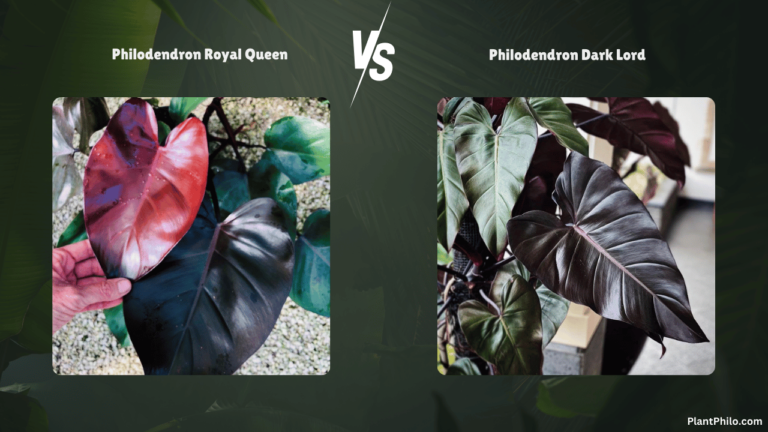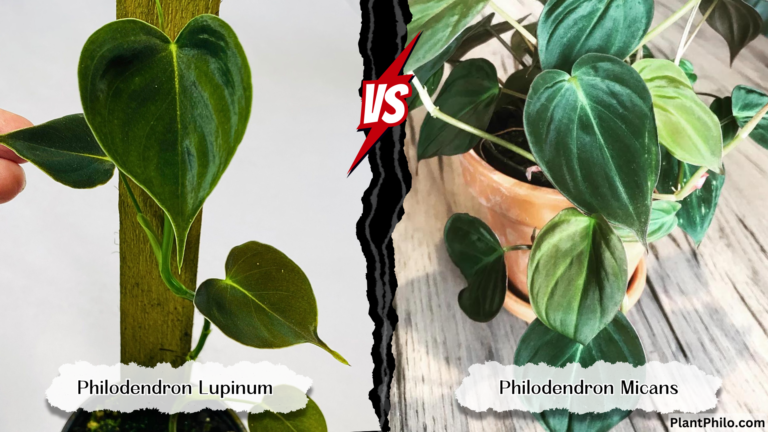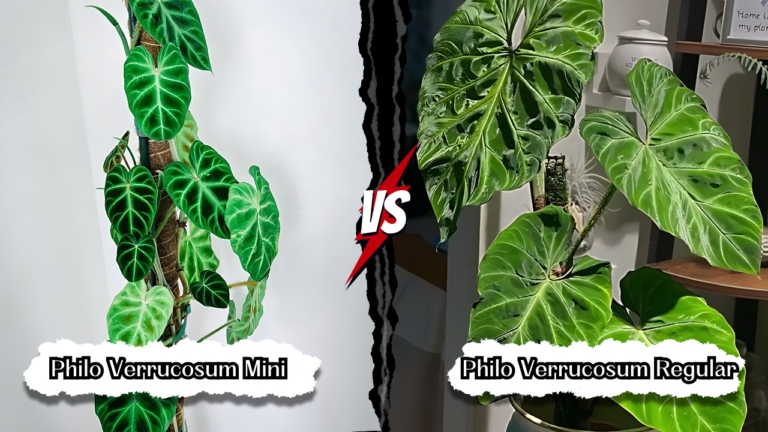Philo Imperial Red vs Black Cardinal: Which Suits Your Space Best?
Philodendrons are beautiful indoor plants known for adding a tropical look to any room. Among the many varieties, the Imperial Red and Black Cardinal are two popular choices for plant lovers. While these philodendrons share some features, each one has unique characteristics that make it special.
Philodendron Imperial Red and Black Cardinal differ most in their leaf color and shape. The Imperial Red has large, heart-shaped leaves with a bold red tone, while the Black Cardinal shows off long, dark leaves with burgundy or nearly black shades. Both plants grow to a considerable size and make eye-catching additions to any plant collection.
When deciding between these philodendrons, think about your style and the décor in your space. The Imperial Red gives a bright pop of color, while the Black Cardinal brings a darker, more dramatic feel. Both are easy to care for and can grow well in many indoor environments, no matter which one you choose.
Key Takeaways
- Leaf color and shape are the main distinguishing features between Imperial Red and Black Cardinal philodendrons
- Both varieties are easy to care for and can grow quite large in the right conditions
- Your choice between these philodendrons depends on your personal style and existing decor
Comparison Table: Philodendron Imperial Red vs. Black Cardinal
| Feature | Philodendron Imperial Red | Philodendron Black Cardinal |
| Botanical Name | Philodendron erubescens ‘Imperial Red’ | Philodendron erubescens ‘Black Cardinal’ |
| Common Names | Imperial Red Philodendron | Black Cardinal Philodendron |
| Origin | Cultivar | Cultivar |
| Growth Habit | Self-heading, can become vining with maturity | Vining, climbing with support |
| Leaf Shape & Size | Large, ovate to cordate (heart-shaped), up to 12-16 inches long | Elongated, lance-shaped to ovate, up to 12-18 inches long |
| Color | Deep burgundy to bronze-red with hints of green, new leaves often bright red | Deep burgundy to almost black, new growth can be brighter red |
| Light Requirements | Bright, indirect light for optimal color; tolerates low light but may lose vibrancy | Bright, indirect light; tolerates low light but color may fade |
| Watering Needs | Water when top 2-3 inches of soil are dry | Water when top 2-3 inches of soil are dry |
| Humidity | Appreciates higher humidity but tolerates average levels | Appreciates higher humidity but tolerates average levels |
| Fertilizing | Balanced liquid fertilizer diluted to half-strength, monthly during growing season | Balanced liquid fertilizer diluted to half-strength, monthly during growing season |
| Common Pests & Diseases | Mealybugs, scale, spider mites, root rot (if overwatered) | Mealybugs, scale, spider mites, root rot (if overwatered) |
| Propagation | Stem cuttings in water or soil | Stem cuttings in water or soil |
| Toxicity | Toxic to pets and humans if ingested | Toxic to pets and humans if ingested |
| Petiole | Long, sturdy, reddish | Long, sturdy, reddish-purple |
| Stem | Thick, upright, may become vining with age | Thinner, vining, can develop aerial roots |
| New Leaf Color | Deep red, maturing to burgundy with hints of green | Bright red, maturing to deep burgundy or almost black |
| Air Purifying | Moderate air purifying qualities | Moderate air purifying qualities |
| Overall Difficulty | Easy to care for | Moderately easy to care for |
| Mature Size | Can reach 3-4 feet tall and wide, may vine with maturity | Can reach 6-8 feet with support |
Botanical Overview
Philodendron Imperial Red and Black Cardinal are stunning tropical plants. They belong to the same genus but have unique characteristics that set them apart. Let’s dive into their taxonomy and natural habitats.
Plant Taxonomy
You’ll find both plants in the Philodendron genus, part of the Araceae family. They’re climbing aroids known for their large, showy leaves. Imperial Red is a cultivar of Philodendron erubescens, while Black Cardinal is its own hybrid variety.
Imperial Red boasts glossy, deep red leaves that mature to dark green. Black Cardinal flaunts velvety, near-black foliage with reddish undersides. Both have similar growth habits, but their leaf colors make them easy to tell apart.
Natural Habitat
In the wild, you’d spot these beauties in tropical rainforests of Central and South America. They love warm, humid conditions with dappled sunlight. Imperial Red naturally climbs trees, while Black Cardinal tends to be more compact.
These plants thrive in rich, well-draining soil. They absorb moisture from the air through aerial roots. In your home, mimic their native environment with high humidity and indirect light. Both varieties can adapt to indoor conditions when given proper care.
Philodendron Imperial Red Characteristics
Philodendron Imperial Red is a striking houseplant with vibrant foliage. You’ll love its eye-catching leaves and compact growth habit that add a tropical flair to any space.
Leaf Morphology
The Imperial Red’s leaves are its standout feature. You’ll notice the rich, dark red color that gives this philodendron its name. The leaves start out a deep burgundy and mature to a glossy dark green with red undersides.
Leaf shape is elongated and heart-shaped, typically 8-12 inches long. The texture is smooth and leathery. New leaves emerge tightly coiled and unfurl to reveal their stunning
Philodendron Black Cardinal Characteristics
The Philodendron Black Cardinal is a striking houseplant with deep, dark foliage and a compact growth habit. You’ll love its dramatic appearance and easy-care nature.
Foliage Features
The Black Cardinal’s leaves are truly spectacular. You’ll be mesmerized by their deep, almost black coloration when mature. Young leaves start out with a reddish-burgundy hue, gradually darkening as they age. The leaves are large, glossy, and heart-shaped, typically growing 8-12 inches long.
Their velvety texture adds another layer of visual interest. When light hits the leaves just right, you might catch a subtle sheen. The undersides of the leaves are often a lighter shade, creating a nice contrast.
Growth Patterns
You’ll find the Black Cardinal to be a relatively compact grower. It tends to form a bushy, upright shape rather than climbing or trailing. This makes it perfect for smaller spaces or as a tabletop plant.
In ideal conditions, you can expect your Black Cardinal to reach about 2-3 feet tall and wide. It grows at a moderate pace, not too fast or slow. New leaves emerge from the center of the plant, unfurling to reveal their rich color.
The plant’s sturdy stems support the weight of the large leaves well. You’ll notice that it doesn’t require much pruning to maintain its shape.
Comparison of Imperial Red and Black Cardinal
These two Philodendron varieties have distinct features that set them apart. You’ll find some shared traits, but their unique characteristics make each one special in its own way.
Key Similarities
Both Imperial Red and Black Cardinal belong to the Philodendron genus. You’ll love how easy they are to care for! These beauties thrive in bright, indirect light and prefer well-draining soil.
They’re both excellent air purifiers, helping to keep your indoor air fresh and clean. You’ll notice their leaves have a similar shape, though the size may vary slightly.
Water needs are comparable for both varieties. You should let the top inch of soil dry out between waterings to keep them happy.
Differences at a Glance
Color is the most striking difference between these two lovelies. Imperial Red boasts vibrant, reddish-purple leaves, while Black Cardinal sports dark, nearly black foliage.
Growth habits differ too. Imperial Red tends to grow faster and can become quite large. Black Cardinal is usually more compact, perfect for smaller spaces.
Leaf texture varies between the two. You’ll find Imperial Red’s leaves are often glossier, while Black Cardinal has a more matte finish.
Temperature preferences also differ slightly. Imperial Red enjoys warmer conditions, while Black Cardinal can tolerate slightly cooler temperatures.
Why people get confused between Philodendron Imperial Red & Black Cardinal
You might find yourself scratching your head when trying to tell these two stunning philodendrons apart. Don’t worry, you’re not alone! Many plant lovers get mixed up.
Both plants have similar leaf shapes and deep, rich colors. This can make it tricky to spot the differences at first glance.
The Imperial Red has leaves that start out a deep, almost black color when young. As they mature, they turn a beautiful burgundy-red.
Black Cardinal, on the other hand, keeps its darker coloration. Its leaves are a deep, purplish-black that can look quite similar to young Imperial Red leaves.
The growth habits of these plants can also cause confusion. Both have a bushy, upright form that can look quite alike, especially when the plants are young.
To tell them apart, focus on the mature leaf color. Imperial Red will have that distinctive red hue, while Black Cardinal stays darker.
Remember, lighting can affect leaf color too! In brighter light, Imperial Red’s leaves may look more vibrant, while Black Cardinal’s might appear slightly lighter.
With practice, you’ll soon be able to spot the subtle differences between these gorgeous philodendrons. Keep observing and you’ll become an expert in no time!
Cultivation and Care
Philodendron Imperial Red and Black Cardinal need similar care. Both thrive with the right soil, water, and light. Let’s dig into the specifics for these beautiful plants.
Soil Preferences
You’ll want to use a well-draining, rich potting mix for your Philodendrons. A mix of peat moss, perlite, and pine bark works wonders. This blend retains moisture while allowing excess water to drain.
For Imperial Red and Black Cardinal, aim for a slightly acidic pH between 5.5 and 6.5. Add a bit of orchid bark to improve drainage. These plants love organic matter, so don’t skimp on compost.
Repot your Philodendron every 2-3 years. Choose a pot 1-2 inches larger than the current one. This gives roots room to grow without risking overwatering.
Watering Requirements
Your Philodendrons prefer consistent moisture. Water when the top inch of soil feels dry. For Imperial Red, this might be every 5-7 days. Black Cardinal can tolerate slightly drier conditions.
Use room temperature water to avoid shocking the roots. Water thoroughly until it drains from the bottom. Empty the saucer to prevent root rot.
In winter, reduce watering frequency. The plant’s growth slows, so it needs less water. Mist the leaves occasionally to boost humidity. Both varieties appreciate this extra moisture.
Light Conditions
These Philodendrons thrive in bright, indirect light. Place them near an east or north-facing window for best results. They can tolerate lower light, but growth may slow.
Too much direct sun can scorch the leaves. If you notice yellowing or brown spots, move the plant to a shadier spot. Imperial Red’s color may fade in very low light.
Rotate your plant every few weeks. This ensures even growth on all sides. If leaves seem pale, gradually increase light exposure. Both varieties adapt well to indoor lighting conditions.
Propagating Techniques
Philodendron Imperial Red and Black Cardinal can both be propagated using simple methods at home. These techniques allow you to expand your collection or share plants with friends. Let’s explore two common approaches.
Stem Cuttings
Stem cuttings are a breeze for propagating these Philodendron beauties. You’ll want to snip a 4-6 inch section just below a leaf node. Make sure your cutting has at least 2-3 leaves attached.
Remove the lower leaves, leaving the top 1-2 intact. Dip the cut end in rooting hormone if you’re feeling fancy, but it’s not a must.
Pop that cutting into a small pot with well-draining soil mix. Keep it moist but not soggy. A clear plastic bag over the top creates a mini greenhouse effect.
In about 3-4 weeks, you should see new growth. Congrats, plant parent! Your baby Philodendron is ready for its new home.
Seed Sowing
Seed propagation is less common but still doable for the adventurous plant lover. You’ll need fresh seeds from a mature Philodendron fruit.
Clean the seeds and soak them overnight in warm water. Prepare a seed tray with a sterile, well-draining mix. Sprinkle the seeds on top and lightly cover with vermiculite.
Keep the soil consistently moist and warm (70-80°F). A heat mat can work wonders here. Be patient – germination can take 2-8 weeks.
Once your seedlings have a few true leaves, carefully transplant them to individual pots. Remember, seedlings may not look exactly like the parent plant at first.
Common Pests and Diseases
Philodendron Imperial Red and Black Cardinal can face some pesky critters and tricky ailments. Keeping an eye out for early signs and knowing how to handle issues will help your plant babies thrive.
Preventative Measures
Darlings, the best defense is a good offense! Keep your Philodendrons happy by giving them the right amount of light and water. Too much moisture can invite fungal issues, so let the soil dry a bit between waterings.
Inspect your plants regularly. Look for any changes in leaf color or texture. Wipe those beautiful leaves with a damp cloth to remove dust and potential pests.
Good air circulation is key. Space your plants out and consider using a fan if the air gets too stuffy. This helps prevent fungal problems.
Mealy bugs can be a nuisance. Keep them at bay by isolating new plants before introducing them to your collection.
Treatment Options
If pests do show up, don’t panic! For mealy bugs, dab them with a cotton swab dipped in rubbing alcohol. It’s like magic!
Fungal issues? Trim off affected leaves and reduce watering. A fungicide might be needed for tougher cases.
Caterpillars munching on your leaves? Handpick them off or use an organic insecticide.
For stubborn infestations, neem oil is a great all-rounder. Mix it with water and a drop of dish soap, then spray your plants weekly.
Remember, consistency is key. Treat your plants regularly until the problem is gone. And always follow product instructions – your plant babies will thank you!
Design and Aesthetic Appeals
Philodendron Imperial Red and Black Cardinal offer striking visual appeal for your indoor and outdoor spaces. Their unique leaf shapes, colors, and growth habits create eye-catching displays that can transform any area.
Indoor Decoration
You’ll love how these philodendrons elevate your interior design. Imperial Red boasts vibrant crimson leaves that add a pop of color to any room. Its upright growth habit makes it perfect for corners or as a standalone statement piece.
Black Cardinal, with its deep burgundy-black foliage, brings drama and sophistication to your space. Its compact form works well on shelves or tabletops. Both varieties thrive in bright, indirect light, making them ideal for offices, living rooms, or bedrooms.
Try grouping these philodendrons with other plants for a lush, tropical vibe. Their contrasting colors create stunning visual interest when paired with lighter green foliage plants.
Landscape Uses
In outdoor settings, these philodendrons shine as focal points in garden designs. You can use Imperial Red to add height and color to shaded areas of your yard. Its bold red leaves create a beautiful contrast against green shrubs or ferns.
Black Cardinal works wonderfully in container gardens or as a groundcover in partially shaded spots. Its dark foliage adds depth and richness to your landscape palette.
Both varieties thrive in humid climates and can be used to create tropical-inspired garden spaces. Plant them near water features or in sheltered patio areas for maximum impact.
Rare Varieties of Philodendron Imperial Red & Black Cardinal
Hey there, plant enthusiast! Ready to dive into some exciting rare varieties of these stunning Philodendrons? Let’s explore some unique cultivars that’ll make your heart skip a beat!
For the Imperial Red, you might come across the ‘Royal Queen’ variety. This rare cultivar boasts even more vibrant red hues than its parent plant. Its leaves shimmer with an almost metallic sheen, making it a true jewel in any collection.
The Black Cardinal has some fascinating variations too. Keep your eyes peeled for the ‘Midnight’ cultivar. Its leaves are so dark they appear almost black, with a velvety texture that’ll make you want to reach out and touch them.
Here’s a quick comparison of these rare beauties:
| Variety | Leaf Color | Special Features |
| Imperial Red ‘Royal Queen’ | Deep red | Metallic sheen |
| Black Cardinal ‘Midnight’ | Near-black | Velvety texture |
Remember, these rare varieties can be tricky to find. You might need to connect with specialized growers or join plant swap groups to get your hands on them. Happy hunting, fellow plant lover!
Fun facts about Philodendron Imperial Red & Black Cardinal
Did you know that Philodendron Imperial Red and Black Cardinal are both stunning foliage plants? These beauties will make your heart skip a beat!
Imperial Red boasts vibrant crimson leaves that’ll add a pop of color to your space. Its bold hues are sure to catch your eye and make you swoon.
Black Cardinal, on the other hand, flaunts deep, dark foliage that’s almost black. It’s like having a touch of mystery in your plant collection!
Both varieties are part of the Philodendron family, which is known for its diverse and popular indoor foliage.
Here’s a fun comparison:
| Feature | Imperial Red | Black Cardinal |
| Leaf Color | Bright red | Deep burgundy to black |
| Growth habit | Upright | Compact |
| Light needs | Bright indirect | Moderate to bright indirect |
These Philodendrons are easy to care for, making them perfect for plant parents of all levels. You’ll love watching them grow and thrive in your home!
Both varieties can help purify the air in your space. It’s like having a natural air freshener that’s also a feast for the eyes!
FAQs: Addressing Your Royal Queries
What’s the main difference between the Royal Queen and Black Cardinal?
The main differences lie in their leaf shape, color intensity, and growth habit. The Royal Queen has broader, heart-shaped leaves with a deep green color and a burgundy sheen, while the Black Cardinal has elongated, triangular leaves with a darker, almost black coloration. The Royal Queen is self-heading, while the Black Cardinal is a climber.
Which plant is bigger between the Royal Queen and Black Cardinal?
The Philodendron Black Cardinal typically grows larger than the Royal Queen, reaching up to 6-8 feet with support.
Can I grow the Royal Queen and Black Cardinal in low light?
They can tolerate low light, but their growth will slow down, and their colors might fade.
How often should I fertilize the Royal Queen and Black Cardinal?
Fertilize monthly during the growing season (spring and summer) with a balanced liquid fertilizer diluted to half-strength.
What’s the best way to increase humidity for the Royal Queen and Black Cardinal?
Misting, pebble trays, and humidifiers are all effective ways to increase humidity.
Can I propagate the Royal Queen and Black Cardinal from leaf cuttings?
No, these Philodendrons cannot be propagated from leaf cuttings alone. You’ll need a stem cutting with at least one node.
How do I know if my Royal Queen and Black Cardinal needs repotting?
If the roots are growing out of the drainage holes or the plant is becoming rootbound, it’s time to repot.
Can I grow the Royal Queen and Black Cardinal outdoors?
Yes, in warm climates with indirect light, but protect them from direct sun and extreme temperatures.
Are the Royal Queen and Black Cardinal safe for pets?
No, both plants are toxic to pets and humans if ingested.
Which plant is more expensive between the Royal Queen and Black Cardinal?
Both plants can be quite expensive due to their rarity and popularity, but prices can vary depending on the size and overall health of the plant.





